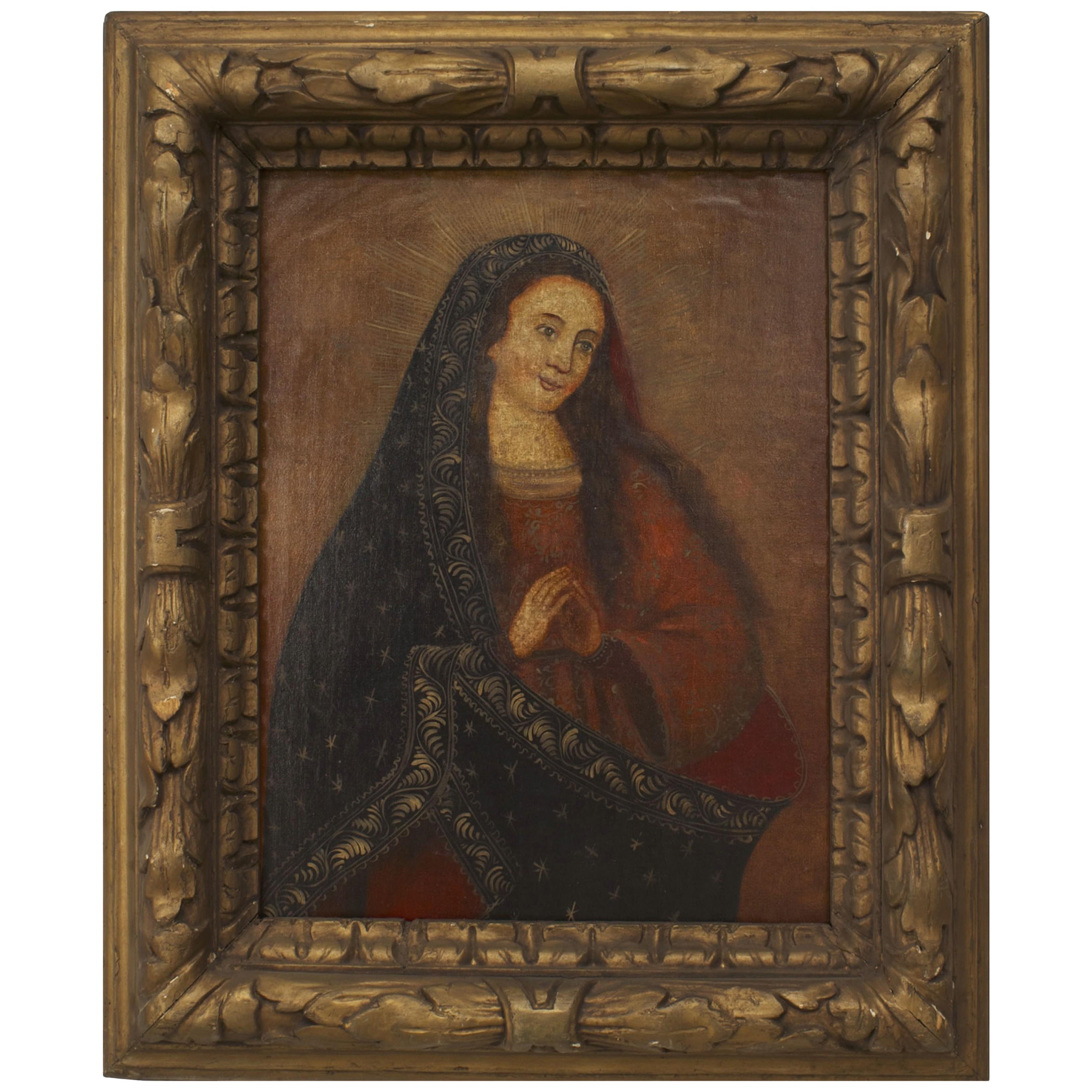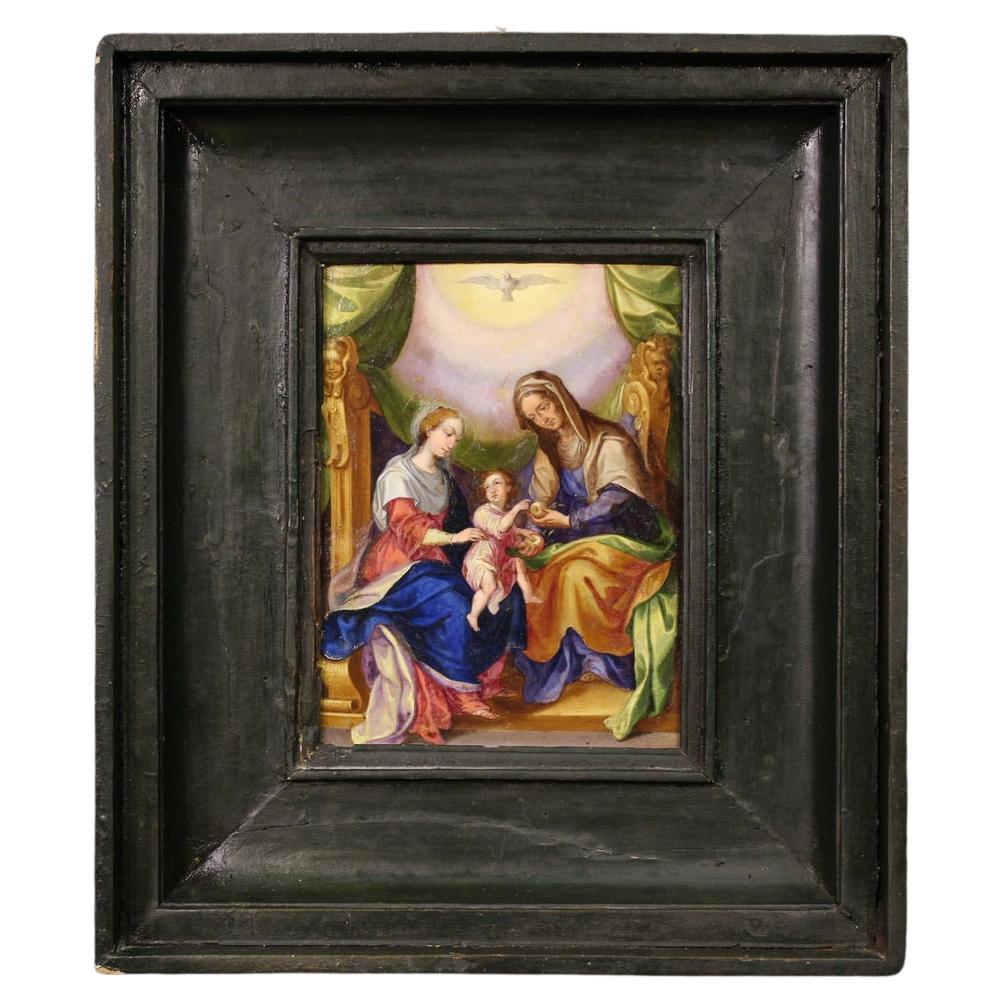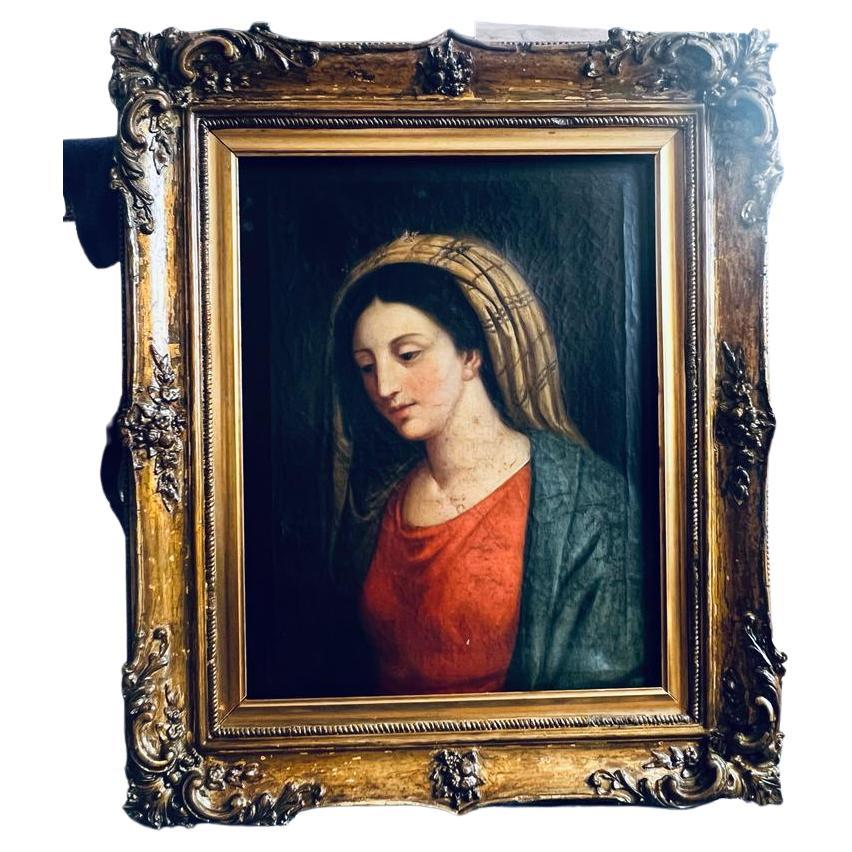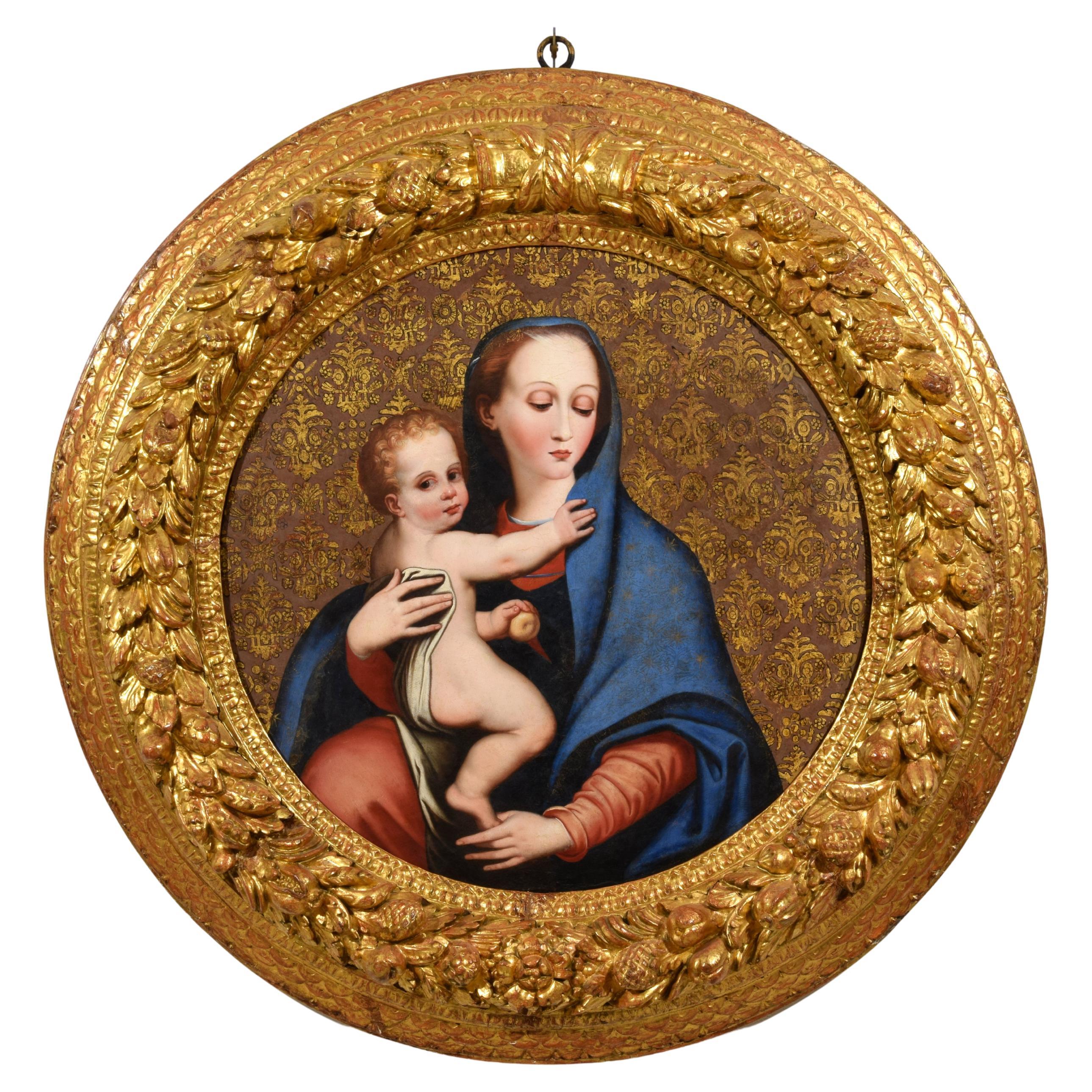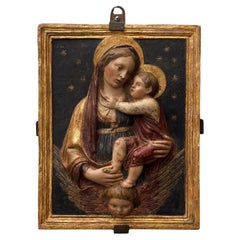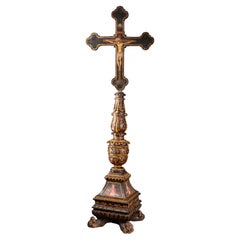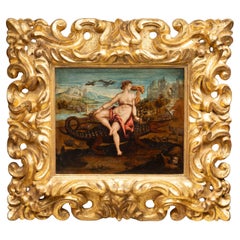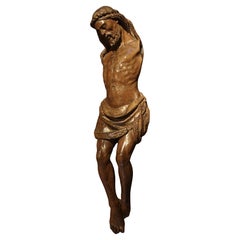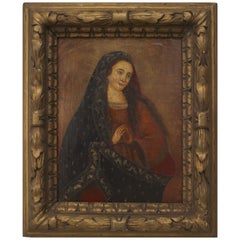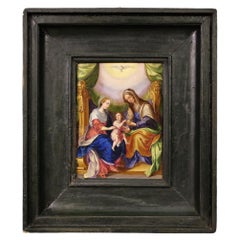Items Similar to Bolognese School of the 16th Century - Mummy of Saint Catherine of Bologna
Want more images or videos?
Request additional images or videos from the seller
1 of 6
Bolognese School of the 16th Century - Mummy of Saint Catherine of Bologna
$3,308.07
$4,135.0820% Off
£2,479.60
£3,099.5020% Off
€2,800
€3,50020% Off
CA$4,544.72
CA$5,680.9020% Off
A$5,073.75
A$6,342.1920% Off
CHF 2,658.57
CHF 3,323.2120% Off
MX$62,107.74
MX$77,634.6720% Off
NOK 33,763.88
NOK 42,204.8520% Off
SEK 31,835.05
SEK 39,793.8220% Off
DKK 21,314.62
DKK 26,643.2820% Off
About the Item
Bolognese School of the 16th Century
Mummy of Saint Catherine of Bologna
Oil on Panel
20,5 x 7 x 0,8 cm
This rare painting depicts Saint Catherine of Bologna as a mummy, housed in a gilded reliquary with an open bottom that reveals the effigy of Saint Petronio, the patron saint of Bologna. Catherine, the abbess and founder of the Poor Clares monastery in Bologna, is portrayed in her characteristic nun's attire.
When she died in 1463, Catherine was buried in the convent cemetery without embalming or a coffin. Despite the lack of flowers around her grave, a fragrant scent of blossoms reportedly lingered in the area for several days. When a group of concerned nuns later exhumed her body, they were astonished to find, as described in a church pamphlet, that she was "intact, flexible, and sweet-smelling."
Inspired by the preservation of her body, the abbesses displayed Catherine in the convent for the sisters to see. A few years later, a nun reported a vision in which Catherine requested to be placed upright in the chapel. The nuns dressed her in a habit and seated her in an ornate golden chair, where she remains today. This painting shows her in the same golden chair that has housed her since the early 16th century.
Visitors to Bologna can still view the chapel containing the mummy of Saint Catherine of Bologna, also known as Saint Catherine de’ Vigri. Born Caterina in 1413 to aristocratic parents Benvenuta Mammolini and Giovanni de’ Vigri, she grew up in a prominent family; her father held an important administrative position for Marquis Niccolò III d’Este in Ferrara.
Around 1424, Caterina became a lady-in-waiting to Margherita d’Este, the illegitimate daughter of Niccolò III, or, according to some sources, his second wife, Parasina Malatesta. The two young women, who were nearly the same age, formed a close friendship and received a well-rounded education that included reading and writing in Italian and Latin, as well as music, calligraphy, and painting.
Caterina joined a community of women in Ferrara leading a religious life without formally taking vows. After a division within the group, she chose to become a member of the faction that established the Poor Clare convent of Corpus Christi. Founded by Saints Francis and Clare of Assisi in 1212, the Poor Clares embraced a life of communal poverty. Caterina lived in this convent from 1431 to 1456, during which time she experienced several visions, including one on Christmas in 1445 when the Virgin Mary showed her the infant Jesus.
In 1456, having become a well-known figure and the Mistress of Novices in Ferrara, Caterina was asked to establish a new Poor Clare convent in Bologna. She served as abbess until her death in 1463. Eighteen days later, her body was found to be remarkably preserved and was exhumed.
Caterina was quickly beatified—a process in the Catholic Church that acknowledges a person’s entrance into heaven and their ability to intercede on behalf of those who pray to them. Miracles began to be attributed to Beata Caterina, as nuns would visit the sick in Bologna with water used to wash her body and pieces of her clothing. By the time she was canonized, a total of 160 miraculous cures had been carefully recorded.
Catherine was declared a saint in 1712.
- Dimensions:Height: 8.08 in (20.5 cm)Width: 2.76 in (7 cm)Depth: 0.32 in (8 mm)
- Style:Renaissance (Of the Period)
- Materials and Techniques:
- Place of Origin:
- Period:
- Date of Manufacture:16th century
- Condition:Wear consistent with age and use.
- Seller Location:Bruxelles, BE
- Reference Number:1stDibs: LU6666241919712
About the Seller
5.0
Vetted Professional Seller
Every seller passes strict standards for authenticity and reliability
1stDibs seller since 2022
15 sales on 1stDibs
Typical response time: 2 hours
- ShippingRetrieving quote...Shipping from: Bruxelles, Belgium
- Return Policy
Authenticity Guarantee
In the unlikely event there’s an issue with an item’s authenticity, contact us within 1 year for a full refund. DetailsMoney-Back Guarantee
If your item is not as described, is damaged in transit, or does not arrive, contact us within 7 days for a full refund. Details24-Hour Cancellation
You have a 24-hour grace period in which to reconsider your purchase, with no questions asked.Vetted Professional Sellers
Our world-class sellers must adhere to strict standards for service and quality, maintaining the integrity of our listings.Price-Match Guarantee
If you find that a seller listed the same item for a lower price elsewhere, we’ll match it.Trusted Global Delivery
Our best-in-class carrier network provides specialized shipping options worldwide, including custom delivery.More From This Seller
View AllAttributed to Domenico di Paris - Madonna and The Child, 15th century
Located in Bruxelles, BE
Attributed to Domenico di Paris, also called Domenico del Cavallo ( Monselice, documented in Ferrara between 1442 and 1501)
Madonna and The Child
Polychromed and gilded Stucco
47,5 ...
Category
Antique 15th Century and Earlier Italian Renaissance Wall-mounted Sculpt...
Materials
Stucco
renaissance wooden candelabrum and painted cross - Umbria, 16th century
Located in Bruxelles, BE
Base of a carved wooden candelabrum, polychrome and gilded; cross painted on both sides.
Umbria or Tuscany, 16th century
136 x 43,5 x 30 cm
(The cross and the base of the candelabrum were later assembled)
The base of the candelabrum is intricately carved and adorned with polychrome and gilded finishes. The shafts take on the shape of balusters reminiscent of ancient columns, feature ornate foliage decorations, garlands and winged cherub faces. The feet are crafted in the likeness of lion paws. The base is further embellished with depictions of four saint martyrs, among them Saint Barbara and Saint Catherine of Alexandria. The plasticity of the figures, outlined with strong contour lines, the clear and vibrant colors, are stylistic elements linked to the Umbrian tradition of the sixteenth century.The precisely defined and elegant drawing, along with the clear color palette applied with refined chiaroscuro modulations, became the signature of a style that would leave a lasting mark on the era to come. This is exemplified by a preference for vibrant, multicolored images, accentuated in this case by the use of red and pink in the saint's attire.
A notable addition, introduced later, is a polylobed cross painted on both sides. On one side, the Crucifixion is vividly portrayed:The treatment of the corpus itself is in line with High Medieval practice, emphasizing pathos by showing Jesus dead, his arms sagging from the weight of the body. The upper section displaying a pelican pecks at her breast to feed her young with her own blood; a symbol of the sacrifice of Christ on the cross whose body and blood similarly nourishes the celebrant during Mass.
The lower part depicts Golgotha. On the reverse side, the Resurrection is artistically presented in a Renaissance iconography, reminiscent of the renowned composition painted by Piero della Francesca, now housed in the Civic Museum of Sansepolcro. In terms of composition, with the frontal depiction of Christ holding the banner, this motif became particularly widespread in central Italy, spanning from Tuscany to Umbria throughout the 16th century..
The double-sided construction suggests that it may also have been carried in liturgical processions. In Umbria from the 14th century, the use of portable crosses painted on both sides had become a widespread practice, aimed at satisfying the monastic clientele that had significantly increased following the establishment of new religious communities.
The earliest surviving Tuscan painted crucifix represent Christ as Christus Triumphans, or the “Triumphant Christ” with his head up and eyes open. This form was supplanted in the 13th century with the Christus Patiens, or “Suffering Christ” type who is shown often with his head fallen on his shoulder and his eyes closed, as In our cross. The iconography of the suffering Christ appears to have developed out of a new interest in Christ’s human nature, the development of the feast of Corpus Christi and with increased importance given to the Eucharist. The process of humanizing the figure of Christ reaches its peak with the abandonment of all the previous expressive conventions in favor of more realistic details we can observe in this Crucifix, such as the swollen belly, the arms stretched to the limit of muscle tearing, the body falling heavily forward, the abundant blood on
the wounds, and the cross firmly embedded in the rock of Calvary.
It's worth noting that Renaissance candelabra...
Category
Antique 16th Century Italian Renaissance Figurative Sculptures
Materials
Wood, Giltwood
Allegory of Africa - 16th century
Located in Bruxelles, BE
Flemish school of the 16th century
Allegory of Africa
After The Allegories of the Continents by Maerten de Vos (engraving by Adriaen Collaert)
Oil on copper
Inscription: "Giulio Ro...
Category
Antique 16th Century Belgian Renaissance Paintings
Materials
Copper
Christ - Umbria, second half of the 15th century
Located in Bruxelles, BE
Christ
Umbria, Orvieto?
Second half of the 15th century
77 x 16.5 cm
Category
Antique 15th Century and Earlier Italian Renaissance Figurative Sculptures
Materials
Walnut
Statuette of the Virgin, South German circa 1600
Located in Bruxelles, BE
Statuette of the Virgin
South-German, circa 1600
sculpted wood
circa 1600
(right arm restored)
52 cm
Category
Antique 17th Century German Renaissance Religious Items
Materials
Wood
Rare pastiglia marriage chest - North of Italy, First half of 15th century
Located in Bruxelles, BE
Rare pastiglia marriage chest
North of Italy, Liguria or Piemonte
First half of 15th century
wood, gesso, partly gilded, form molded and painted
67 x 156 x 63 cm
Provenance :
Pri...
Category
Antique 15th Century and Earlier Italian Renaissance Blanket Chests
Materials
Gesso, Wood
You May Also Like
16th/17th Century Orthodox Religious Icon on Board of the Virgin Mary and Jesus
Located in Hastings, GB
An impressive and large scale painting on board of the Mother Mary holding the infant Jesus, each displayed wearing a crown with a golden sacred heart, probably Hungarian, the inscription underneath reads ‘Zdravas Kralovno’ in Slovak, which translates to the Latin Salve Regina or Hail, Queen, these are a reference to the Latin Hymn of the same name, which is traditionally thought to have originated in 11th century Germany, and specifically to the monk Hermann of Reichenau.
Unlike the Icons of Catholicism, these Eastern Orthodox Icons...
Category
Antique 17th Century Hungarian Baroque Paintings
Materials
Wood
Spanish Renaissance Madonna Portrait
Located in Queens, NY
Spanish Renaissance style (20th Cent) oil painting portrait of Madonna in gold frame
Category
20th Century Unknown Renaissance Paintings
Materials
Paint
17th Century Icon on Board of Saint Matrona
Located in Hastings, GB
Incredibly rare Icon on Oak board dating to the 17th century and depicting Saint Matrona (Agia Matrona), this Icon was originally from Chios in Greece and was discovered in Vatopedi...
Category
Antique 17th Century Greek Renaissance Paintings
Materials
Wood
18th Century Oil on Copper Italian Antique Religious Painting, 1740
Located in Vicoforte, Piedmont
Rare 18th-century Italian painting. Refined oil-on-copper miniature depicting the Virgin Mary, Saint Anne, and the Baby Jesus. The two women are seated on a large gilded throne. At t...
Category
Antique 1740s Italian Paintings
Materials
Copper
Antique 17th Century Painting Madonna /Virgin Mary Italy Oil on Canvas
Located in Doha, QA
Magnificent Italian 17th century Portrait of Virgin Mary measures 52 x 68 cm without the frame.
The colors are stunning and the paintin...
Category
Antique 17th Century Italian Baroque Paintings
Materials
Canvas
17th Century, Italian Oil on Panel Painting Depicting Madonna della Purità
Located in IT
17th Century, Italian Oil on Panel Painting Depicting Madonna della Purità
The painting, executed in oil on a circular wooden panel and presented in an imposing carved and gilded wo...
Category
Antique 17th Century Italian Renaissance Paintings
Materials
Wood, Giltwood
More Ways To Browse
Francis Assisi
Christmas Clothing
Giovanni Bologna
Jesus Praying
Used Furniture Corpus Christi
Saint Clare
Virgin Mary Clothing
Praying Chair
Infant Coffin
Obi Fabric
Qing Lacquer Screens
Quilt Cabinet
Robert Wood Iron
Schumacher Wallpaper Mural
Silver Conch Shell
Small Japanese Tansu
Stone Lion Chinese
Stone Top Bedside Table
